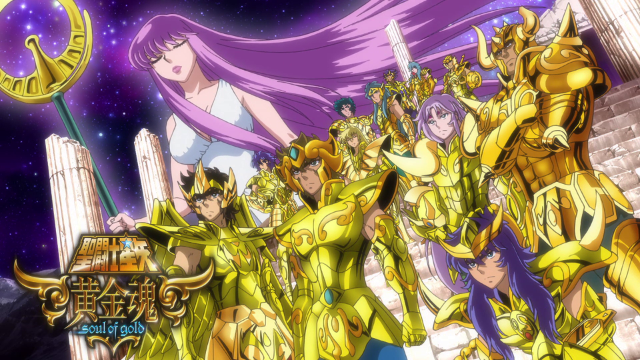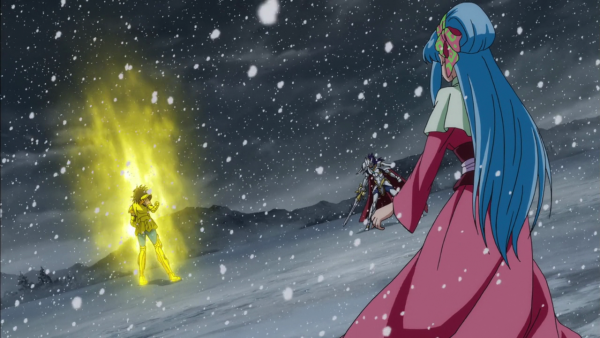
Saint Seiya: Soul of Gold is a new original net animation that started at the beginning of the summer season. It is a spin off of the classic Saint Seiya anime from 1986. The show is comprised of entirely new material, not being based on any unadapted manga from the long-running franchise.
In the original Saint Seiya TV series, the Goddess Athena had an army of warriors that devoted themselves to her. The most powerful of which were her Gold Saints. She enlisted the help of the Gold Saints to aid in her fight against Hades. The Gold Saints sacrificed their lives to take down the Wall of Gold. This enables Seiya's group to pass through and protect Athena from Hades.
Saint Seiya: Soul of Gold begins with the twelve Gold Saints that took down the Wall of Gold being brought back to life in the land of Asgard. The series starts with Leo Aiolia befriending a young woman named Lyfia. Leo wonders why he was brought back and thinks he should find his way back to the Underworld to assist Athena once again. However, Lyfia begs Leo to stay in Asgard to help the evil that has befallen the land.
The evil in Asgard stems from the tree Yggdrasil. Yggdrasil was said to be forbidden, but it was regrown by Andreas Lise, claiming to be carrying out the will of Odin (the chief God in Asgard). Andreas also has an army of God Warriors that fight for him. Asgard is a land that is subject to harsh wintery climates all the time. When Yggdrasil blossoms, it gives the people of Asgard a surplus of crops and agriculture that everyone is grateful for. However, Lyfia knows that Yggdrasil is forbidden for a reason and finds out there is a cosmic evil brewing inside the tree. After Lyfia recruits Aiolia, all twelve Saints coalesce to fight off the darkness Andreas has bestowed upon Asgard.
Mythological References
The original Saint Seiya is known for making direct references to Greek mythology. Soul of Gold still continues this forward with the characters that are carried over from the first series. However, what sets Soul of Gold apart from its predecessor are its references to Norse Mythology. The original anime touched on these references, but they are at the forefront in Soul of Gold.
Asgard

In the Norse Myths, Asgard is home to the Æsir Gods and three of the Vanir Gods. There are twelve Gods and Goddesses, each with their own hall in Asgard. Chief among the Gods is Odin and chief among the Goddesses is Odin's wife, Frigg. In Soul of Gold, Asgard is still home to Odin. However, the Asgard of the show is a monotheistic one, with Odin being the only God. There are the God Warriors who fight for him, but they are not deities themselves. The show doesn't acknowledge any of the other Norse Gods such as Frey, Freyja, or Tyr.
Asgard is also seen as being in an eternal winter. Snow and harsh winds persist every day in the Asgard of Saint Seiya. If we compare this to the Norse Asgard, we find that this is actually not the case. Neither in The Prose Edda or The Poetic Edda (the two key sources on Norse Paganism) is there reference made to Asgard's climate. However, this is not the first time a fictional work has portrayed Asgard in this way. In Robert E. Howard's Hyborian Age, he too described Asgard as being a land of winter. Perhaps Saint Seiya's head writer, Toshimitsu Takeuchi, was influenced by Howard. Or, both of them could have taken the idea from the fact that Scandinavia, where the myths were created, is a cold place with harsh and long-lasting winters.
Yggdrasil

The mythological Yggdrasil is known as The World Tree. It is a giant ash tree that the nine realms that comprise the world are connected to. Obviously, over time this belief has been unproven by science, but it still stands as a part of the Norse myths. In the anime, Yggdrasil is a tree that exists in Asgard. This is an inverse of the Norse Yggdrasil because Asgard, being one of the nine realms, stems from The World Tree.
Valhalla and The Einherjar

Saint Seiya's Valhalla is a palace that is used for political meetings and prayer. It is where Andreas meets with the God Warriors and the soldiers that serve them. They discuss their tactics and plans there. Characters can also be seen praying to Odin inside the palace. The Einherjar are introduced in later episodes of the series. They are a legion of dead warriors that are brought back to life by the God Warriors to fight for them. They resemble zombies.
Valhalla is Odin's hall. It is enormous and has a roof made of golden shields. Valhalla is where warriors who died in battle go by way of the Valkyries (warrior women of Asgard sent by Odin to determine who lives and dies in battle). In Valhalla, these warriors would fight and train all day in preparation for Ragnarok (the ending battle where many Gods die). In the evening, the Valkyries bring the warriors an endless supply of mead, courtesy of the goat Heidrun. In the old myths, these warriors who inhabit Valhalla are referred to as the Einherjar. This differs from the show wherein the soldiers of Valhalla are separate from the Einherjar the God Warriors resurrect. Also in the myths, the Gods do not discuss political matters in Valhalla. This is instead done at the Well of Wyrd beneath Yggdrasil.
If you like epic large scale action shows, Saint Seiya: Soul of Gold is for you. The intertwining of different mythologies causes this show to operate on an astronomical scale. It is a shounen action series, so the fights are long. The characters will use their different powers and "level up" to different Gold Cloths to inflict more damage upon their enemy. The show is so over the top, it often delves into cheesiness. I think that's part of the fun however. It's so ridiculous and grandiose that it has a charm and is enjoyable to watch. If you have any interest in mythology, I won't say you will learn a lot from this show, but you will find it entertaining. The show also has some excellent orchestral music by Toshihiko Sahashi, that elevates the size of the show. If I had to describe Saint Seiya: Soul of Gold in two words, I would say "fun" and "epic." If those two words appeal to you, then I would definitely recommend giving it a watch.
Similar Titles
Here are some shows that are similar to Saint Seiya: Soul of Gold. I'm not including other iterations of the Saint Seiya franchise because that would be obvious.
Dragon Ball Z

It's clear that the Saint Seiya and Dragon Ball franchises were contemporaries. Masami Kurumada's original Saint Seiya manga came out just two years after Akira Toriyama began Dragon Ball. Both shows have epic drawn out fight sequences. Both have a cosmic scale. Both have a large cast of characters, each with their own unique personality. Both are ridiculously over the top and entertaining. The only difference that sets DBZ apart is the humor. Toriyama had a very distinct sense of humor that bled into his works, whereas Saint Seiya is more straight faced.
Yuu Yuu Hakusho

I would compare Saint Seiya to Yu Yu Hakusho for similar reasons as Dragon Ball. Large scale fighting. Characters "leveling up." Fight scenes that last for several episodes at a time. A stronger emphasis on action than character development. You get the idea, big shounen-y and action-y fun.
Heroman

I was reminded of Heroman quite a few times while watching Soul of Gold. Heroman is about an alien invasion on Earth. A boy and his mech have to team together to fight and save the world from evil. Both shows have clearly defined "good" heroes and "evil" villains. The cosmic element is also present in both shows.
Heroic Age

Heroic Age was a mecha show that was based on Greek mythology. Anime that play around with mythology are pretty rare to come by. It's not like Western media that references mythology all the time (Hercules, Xena, Thor, Clash of the Titans, etc...) For the fact that both make allusion to the Greek pantheon, I would say Heroic Age is a nice companion piece to Saint Seiya: Soul of Gold.
B't X

B't X is a mecha series from the late 90's. It is based on a manga by Saint Seiya's author, Masami Kurumada. Although it fits comfortably into the mech genre, many of Kurumada's trademarks can still be seen. The character designs and art style are incredibly similar. The heavy use of action scenes that go on for long stretches of time are also a feature of both series. B't X even managed to have its main character ride a robot that's shaped like Pegasus!




